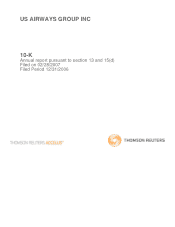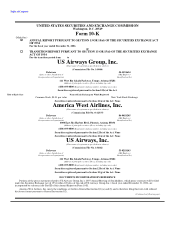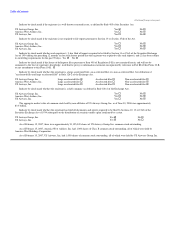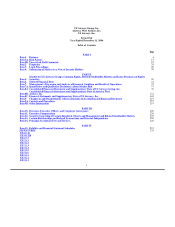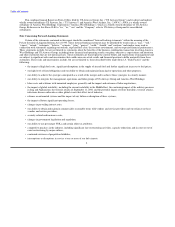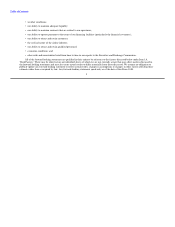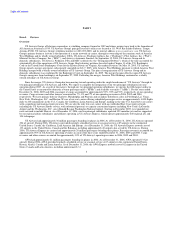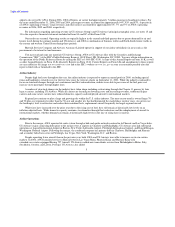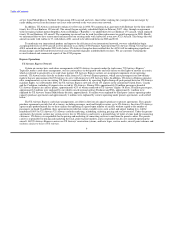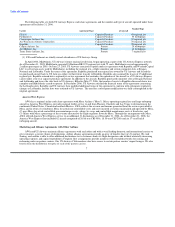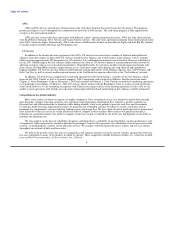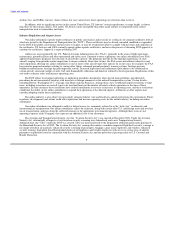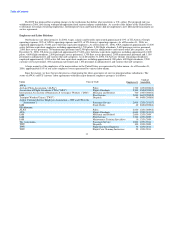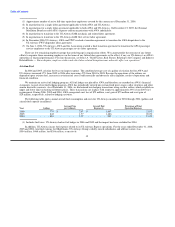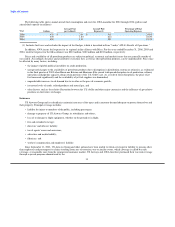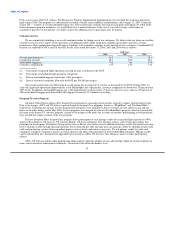US Airways 2006 Annual Report Download - page 8
Download and view the complete annual report
Please find page 8 of the 2006 US Airways annual report below. You can navigate through the pages in the report by either clicking on the pages listed below, or by using the keyword search tool below to find specific information within the annual report.
Table of Contents
airports also served by AWA. During 2006, AWA's Express air carrier had approximately 7 million passengers boarding its planes. For
the years ended December 31, 2006, 2005 and 2004, passenger revenues accounted for approximately 94%, 93% and 93%, respectively,
of AWA's operating revenues. Cargo revenues and other sources accounted for approximately 6%, 7% and 7% of AWA's operating
revenues in 2006, 2005 and 2004, respectively.
For information regarding operating revenue in US Airways Group's and US Airways' principal geographic areas, see notes 15 and
13 to the respective financial statements included in Items 8A and 8C of this Form 10-K.
Our results are seasonal. Operating results are typically highest in the second and third quarters due to greater demand for air and
leisure travel during the summer months and US Airways' and AWA's combination of business traffic and North-South leisure traffic in
the eastern and western United States during those periods.
Material Services Company and Airways Assurance Limited operate in support of our airline subsidiaries in areas such as the
procurement of aviation fuel and insurance.
You may read and copy any materials US Airways Group, AWA or US Airways files with the Securities and Exchange
Commission ("SEC") at the SEC's Public Reference Room at 100 F Street, NE, Washington, DC 20549. You may obtain information on
the operation of the Public Reference Room by calling the SEC at 1-800-SEC-0330. A copy of this Annual Report on Form 10-K, as well
as other Annual Reports on Form 10-K, Quarterly Reports on Form 10-Q, Current Reports on Form 8-K and amendments to those reports
are accessible free of charge at www.usairways.com and at the SEC's website at www.sec.gov as soon as reasonably possible after the
report is filed with or furnished to the SEC.
Airline Industry
Despite high fuel costs throughout the year, the airline industry is expected to report an annual profit in 2006, excluding special
items and bankruptcy-related costs, for the first time since the terrorist attacks on September 11, 2001. While the industry continued to
focus on structural changes through cost containment and fleet rationalization, airlines were able to pass some of the fuel price cost
increase on to passengers through higher fares.
A number of structural changes in the industry have taken shape including restructuring through the Chapter 11 process by four
legacy carriers, including US Airways. While all carriers are focusing on lowering costs and increasing revenues, traditional legacy
carriers and some newer carriers have reduced domestic capacity and redeployed aircraft to international markets.
Regional jets continue to play a large and growing role within the U.S. airline industry. The more recent trend is toward larger 70-
and 90-plus seat regional jets rather than the 50-seat and smaller jets that had dominated the marketplace in prior years. As carriers use
the bankruptcy laws to restructure and reduce their mainline fleets, replacement aircraft frequently are larger regional aircraft.
While fares have increased over the prior year due to the rising cost of fuel, they still remain at historically low levels on an
inflation-adjusted basis. While domestic capacity continues to rationalize through fleet reductions and the redeployment of aircraft to
international markets, whether demand can remain at historically high levels in the face of rising fares is unclear.
Airline Operations
Prior to the merger, AWA operated its route system through a hub-and-spoke network centered in its Phoenix and Las Vegas hubs.
US Airways' major connecting hubs prior to the merger were at airports in Charlotte and Philadelphia. US Airways also had substantial
operations at Logan International Airport in Boston, New York's LaGuardia Airport, Pittsburgh International Airport, and Ronald Reagan
Washington National Airport. Following the merger, the combined company has primary hubs in Charlotte, Philadelphia and Phoenix
and secondary hubs/focus cities in Pittsburgh, Las Vegas, New York, Washington, D.C. and Boston.
Despite operating fewer aircraft than in the previous year, both AWA and US Airways were able to increase service in certain
markets. In 2006, AWA launched service to Hawaii between Las Vegas-Maui, Phoenix-Kauai and Phoenix-Kona with
extended-over-water-equipped Boeing 757 Aircraft. US Airways added new transatlantic service from Philadelphia to Milan, Italy;
Stockholm, Sweden; and Lisbon, Portugal. US Airways also added
5

